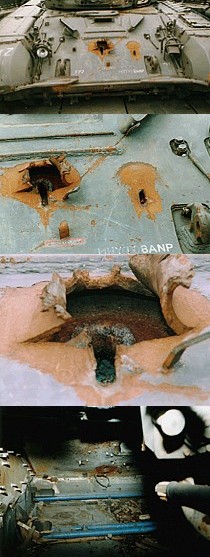|
|
T-72M1 at Haide  The bulk of the former East-German tanks were scrapped. The T-72 was no exception. They were brought to Haide and some of them suffered ballistic test before being disassembled for recovery and smelting. |
 Shooting Trials
Shooting Trials
Right: Front showing multiple hits of DM33 APDSFS and DM12 HEAT rounds of 105 mm L7A3 gun. While HEAT rounds could penetrate the hull, only DM33 APDSFS projectiles could achieve some degree of penetration of the turret front when fired at less than 1500 m. |
 Break through
Break through
Right: Glacis showing two penetration holes due to a DM12 HEAT shaped charge and a DM33 APDSFS projectile fired from 2000m. The 17mm add-on armour blew off after being struck by the chemical warhead, leaving a big hole in comparison with the fine kinetic break through.
Comment: Although remarkably well armoured for a 40 ton tank, the principal design flaw is related to the tendency to set on fire once penetration ocurrs. The cramped interior, the hughe autoloader and the lack of compartmentalisation of ammunition favors the striking of propelant charges with catastrophic consecuences. Usually, the fire spreads quickly into the ammunition cassette, promoting a high order detonation and blowing the turret off after incinerating the tank interior. |